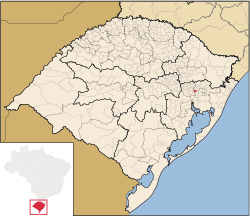Estância Velha
This article needs additional citations for verification. (January 2021) |
Estância Velha | |
|---|---|
 | |
 Location within Rio Grande do Sul | |
| Coordinates: 29°39′S 51°11′W / 29.650°S 51.183°W | |
| Country | |
| State | Rio Grande do Sul |
| Population (2020[1]) | |
| • Total | 50,672 |
| Time zone | UTC−3 (BRT) |
Estância Velha is a municipality in the state of Rio Grande do Sul, Brazil. Its population was 51 292 inhabitants, according to 2021 IBGE data.
History[edit]
The history of Estância Velha begins with the arrival of the indigenous people. After the indigenous participation, it is recorded that in 1788 it was part of the Real Feitoria do Linho Cânhamo, set up on the banks of the Rio dos Sinos, to occupy the area for the Portuguese Crown and produce hemp - a raw material for making ship rigging and which Portugal exported to other countries. As the occupation plan did not have the desired effect, in 1824, already in Imperial Brazil, Dom Pedro distributed the lands of the Real Feitoria to German immigrants who had arrived in São Leopoldo. The first German immigrant to settle in Estância Velha was Mathias Franzen, who felled the bush and planted crops. As a shoemaker, in 1830 he also practiced the trade he had learned in Europe. This was followed by the arrival of several immigrant families.
Still in the 19th century, the basis for the town's industrial development was created. Estância Velha's leather tradition dates back to 1890, at first focused on the manufacture of saddles and riding accessories, later dedicated to the tanning of hides and skins and the production of footwear, the region's main vocation. With the development of industry and agriculture remaining strong, Estância Velha was elevated to the seat of the tenth district of São Leopoldo on 15 January 1930. The emancipation movement fought for nine years so that, on 8 September 1959, Estância Velha was emancipated.
Geografy[edit]
Belongs to the List of mesoregions and microregions of Rio Grande do Sul. It is one of the municipalities in the Sinos River basin.





